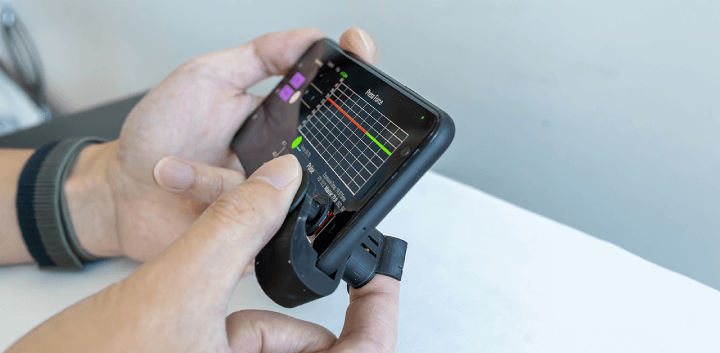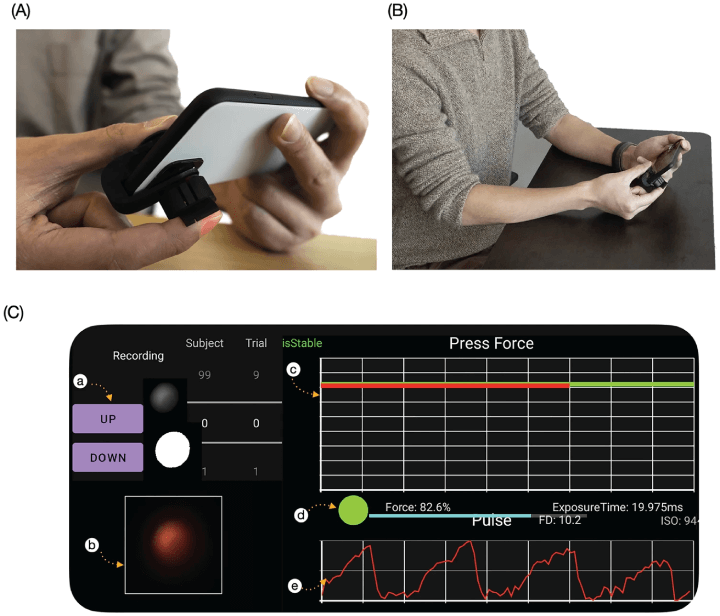Low Cost Smartphone Attachment Enables Fingertip Blood Pressure Monitoring
20-06-2023 | By Robin Mitchell
Recently, researchers from the University of California have published their development on a cuffless blood pressure sensor that could pave the way for non-intrusive blood pressure sensing in wearables. What challenges do blood pressure measurements introduce, what did the researchers develop, and how could it help with future health monitoring?
What challenges do blood pressure measurements introduce?
Health monitoring devices capable of recording bioactivity have been around for at least a decade, but it has only been the rise of AI and advanced data analytics that have made them immensely popular thanks to their predictive and diagnostic capabilities. Simply knowing one’s heart rate at any time can only provide so much medical insight, which is why first-generation wearables struggled to be medically beneficial. However, when second-generation wearables started to record this data, it became possible to see trends in health, and combining that data with advanced AI algorithms allows for basic diagnostics of potential health issues.
In a modern health wearable, the most common biomarkers that are recorded are heart rate and bloody oxygen. If that wearable incorporates an accelerometer, then the activity can also be recorded, giving insight into calories burned and even lung capacity determined by the number of breaks taken during activities. Some modern devices (such as the Apple Watch) are even able to integrate real ECG sensors that measure the electrical activity of the heart, revealing potentially dangerous conditions such as fibrillation.
However, one biomarker that has proven extremely difficult to measure using wearables is blood pressure, and just like heart rate and blood oxygen, it is an extremely important marker to record. In fact, of all bio signs that can be measured, blood pressure could be argued to be one of the most important ones, as blood pressure is often related to numerous health conditions, including heart failure and stress. So, why is measuring blood pressure with a wearable so difficult?
Electronic blood pressure devices that anyone can purchase are already available and are often very cheap. In fact, measuring blood pressure is incredibly easy; a simple pressure sensor, arm cuff, and air pump can do this with minimal electronics. However, the challenge faced by engineers is trying to make a reliable blood pressure sensor without using a constrictive device.
When taking blood pressure measurements, a cuff is inflated around the arm until blood flow is no longer detected, and while this is perfectly adequate at a surgery or hospital, it is far from practical in a wearable device. Having a strap that inflates with air would work to provide reliable and accurate results, but this would undoubtedly be highly uncomfortable for wearers. Each time a pressure reading is taken, the strap constricts the wearer’s wrist so much that blood flow to the hand is halted, and this would not only cause discomfort but also potentially interfere with daily activities such as driving and typing.
Some researchers have explored the use of optical sensors for measuring blood pressure, and while it can work in some instances, the reliability and accuracy of such sensors are not sufficient for practical use. As such, blood pressure monitoring remains out of reach for current wearables.
Researchers create non-intrusive blood pressure monitor
Recognising the challenges faced with blood pressure monitoring in wearables, a team of researchers from the University of California have demonstrated a new attachment and software for regular smartphones that can produce accurate blood pressure readings.
 The blood pressure monitoring clip prototype allows users to apply pressure, while a dedicated smartphone app provides guidance on intensity and duration. Photos courtesy of the Digital Health Lab / UC San Diego.
The blood pressure monitoring clip prototype allows users to apply pressure, while a dedicated smartphone app provides guidance on intensity and duration. Photos courtesy of the Digital Health Lab / UC San Diego.
Instead of designing a custom sensor and associated hardware, the researchers decided to utilise tools that are already widely accessible. By doing so, not only can the researchers demonstrate that optical blood pressure readings are possible, but they can even be potentially scaled into wearables and other everyday electronics.
To enable a smartphone to optically take blood pressure readings, the researchers designed a device that can clip over a smartphone’s camera and screen simultaneously while the user pinches the device with their thumb and index finger. The light from the flash is projected onto the finger as a small dot, and this dot is picked up by the camera. As the pressure against the clip increases (i.e. squeezing harder), the size of the dot increases in size, and this allows an algorithm to infer the pressure being applied to the clip.
 System usability with BPClip: (A) Align right index fingernail base with the notch. (B) Hold phone and clip at heart level. (C) UI layout of the app: a. force range adjustment button; b. real-time camera image preview; c. force indicator (red line for current force, green line for target force); d. force range indicator (red circle for out of range, yellow circle for within range, green circle for recording with progress bar); e. real-time pulse signal display.
System usability with BPClip: (A) Align right index fingernail base with the notch. (B) Hold phone and clip at heart level. (C) UI layout of the app: a. force range adjustment button; b. real-time camera image preview; c. force indicator (red line for current force, green line for target force); d. force range indicator (red circle for out of range, yellow circle for within range, green circle for recording with progress bar); e. real-time pulse signal display.
The brilliance of this design lies in its simplicity and use of readily available technology. The researchers have essentially transformed a smartphone into a blood pressure monitor, using nothing more than a clip and the phone's built-in camera and flash. This is a prime example of how innovative thinking can lead to breakthroughs in medical technology.
As Edward Wang, professor of electrical and computer engineering at UC San Diego and director of the Digital Health Lab, explains, 'Our is a calibration-free system, meaning you can just use our device without touching another blood pressure monitor to get a trustworthy blood pressure reading. This is what distinguishes our device from other blood pressure monitors.' This innovative approach to blood pressure monitoring could revolutionise the way we track this vital health metric.
However, it turns out that when squeezing against the clip, the natural changes in blood pressure also induce changing pressures against the clip, and these can also be identified by the camera. As such, this addon device to the camera allows for blood pressure to be inferred without needing to use restrictive hardware.
This development is particularly significant given the prevalence of hypertension, or high blood pressure, in today's society. According to the Centers for Disease Control and Prevention (CDC), hypertension was a primary or contributing cause of over 690,000 deaths in the United States in 2021. With nearly half of all adults in the US suffering from hypertension, the need for easy and affordable blood pressure monitoring is clear.
How could this help with future wearables?
If the technology developed by the researchers can be expanded into a wearable device, then it would arguably transform the medical applications of wearable devices. With being able to actively monitor blood pressure, long-term changes in blood pressure can be monitored, and possibly even identify immediate risks to health.
However, placing a device on the finger will unlikely be popular with consumers, but there are two potential alternatives. One option is placing the sensor on the underside of a wearable, and so long as a dot can be projected onto the skin, it might be possible to perform a blood pressure measurement from the wrist. It is also possible to incorporate this technology into a ring-like device, but due to the vast size differences in ring size, this would not be a one-size fits all approach.
Overall, what the researchers have demonstrated is an excellent step in the right direction for medical wearables, and if these researchers can figure out how to incorporate their design into a wearable watch, it will surely become a massive commercial success.
The wearable technology market is booming, with global sales expected to reach $XX billion by 202X. Fitness trackers and smartwatches are among the most popular types of wearable devices, but the market is continually evolving as new technologies and applications are developed. The introduction of a wearable blood pressure monitor could significantly disrupt this market, providing a valuable new tool for health monitoring and potentially driving the growth of the wearable medical device segment.
The researchers are already looking to the future, with plans to improve the user experience and compatibility with different smartphone models. They have founded a company, Billion Labs Inc., to continue the development and commercialisation of this technology. With their innovative approach and commitment to making blood pressure monitoring more accessible, the future of health wearables looks bright.
The potential for this technology is vast. As Wang notes, 'Because of their low cost, these clips could be handed out to anyone who needs them but cannot go to a clinic regularly.' This could make blood pressure monitoring more accessible and affordable for millions of people around the world.
Potential Applications and Challenges Ahead
Imagine a world where individuals with hypertension can effortlessly monitor their blood pressure throughout the day, allowing for more accurate readings and better management of their condition. Or consider the potential for athletes to track their blood pressure during workouts, providing valuable data that could help optimize their training routines. These are just a few of the many potential applications for this groundbreaking technology.
As the researchers continue to refine their design and explore potential applications, we can expect to see more advancements in this field. Whether it's a wearable watch or a ring-like device, the possibilities for non-intrusive blood pressure monitoring are exciting. And with the potential for mass production and low manufacturing costs, this technology could soon become a common feature in our everyday lives.
Despite the many potential benefits of this technology, there are also several challenges that must be overcome before it can be widely adopted. For one, the accuracy of the readings must be validated in large-scale clinical trials. Additionally, there may be regulatory hurdles to overcome, as any device used to monitor blood pressure would likely be classified as a medical device and subject to stringent safety and efficacy requirements. Finally, consumer acceptance of this technology is not guaranteed. While the convenience of a wearable blood pressure monitor is undeniable, some individuals may be reluctant to adopt this technology due to concerns about privacy or the potential for over-reliance on technology for health monitoring.

